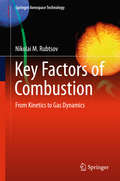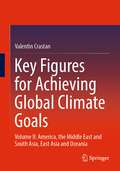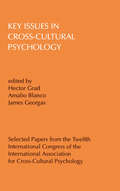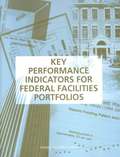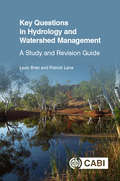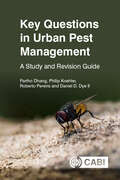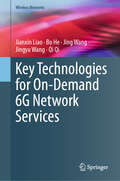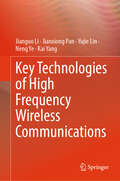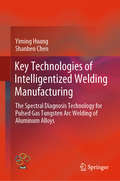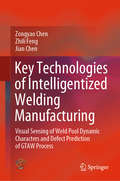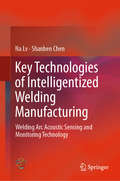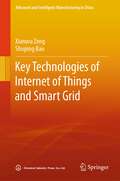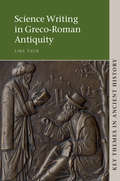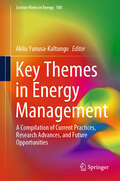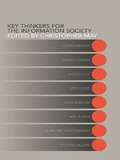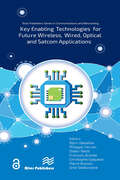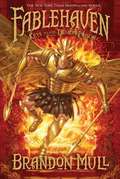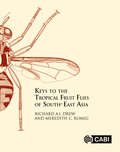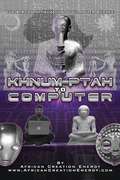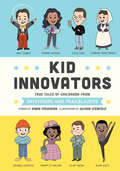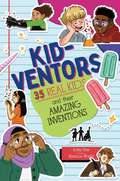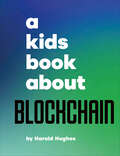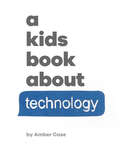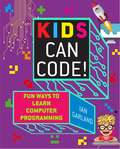- Table View
- List View
Key Factors of Combustion
by Nikolai M. RubtsovThis book summarizes the main advances in the mechanisms of combustion processes. It focuses on the analysis of kinetic mechanisms of gas combustion processes and experimental investigation into the interrelation of kinetics and gas dynamics in gas combustion. The book is complimentary to the one previously published, The Modes of Gaseous Combustion.
Key Figures for Achieving Global Climate Goals: Volume II: America, the Middle East and South Asia, East Asia and Oceania
by Valentin CrastanThis volume analyses the energy industry for the following geographical units: America – divided into North America (Canada + USA) and Central and South America –, the Middle East and South Asia, East Asia and Oceania. The key energy-economic indicators for each region and country and their development, are illustrated in numerous graphs and energy flow diagrams. Based on this analysis, the author recommends a distribution of emission reductions necessary to limit climate change (for the 2°C and 1.5°C climate goals, with a perspective up to 2050).The continents covered in this volume collectively account for 77% of emissions. Europe + Eurasia and Africa will be addressed in volume I.
Key Issues in Cross-cultural Psychology
by Hector Grad; Amalio Blanco; James GeorgasThese proceedings are organized into six parts, covering conceptual and methodological issues; consequences of acculturation; cognitive processes; values; social psychology; and personality, developmental psychology and health psychology.
Key Performance Indicators For Federal Facilities Portfolios
by Federal Facilities CouncilMore than 30 federal departments and agencies with a wide range of missions and programs manage large inventories of facilities, also called portfolios. These portfolios range in size from a few hundred to more than a hundred thousand individual structures, buildings, and their supporting infrastructure. They are diverse in terms of facility types, mix of types, and geographic dispersal. For federal senior executives, facilities portfolio-related decisions revolve around the allocation of resources (staff, funding, time) for acquisition, renovation, operation, repair, and disposition of facilities. To make informed decisions, senior executives require information that will allow them to answer such questions as: What facilities do we have? What condition are they in? What facilities are needed to support the organization’s missions? This study lays out a framework for developing and evaluating trends in facilities portfolio conditions, investments, and costs and identifies a set of key indicators that can be used to track performance over time. Some of the indicators are currently in use in some federal agencies; others will need to be developed.
Key Questions in Hydrology and Watershed Management: A Study and Revision Guide (Key Questions)
by Professor Leon Bren Professor Patrick LaneThis book provides a series of exercises of various types covering matters of hydrology and watershed management. The exercises include true/false questions, multiple choice questions, and numeric, graphical, and analytical exercises. The questions draw on the basic disciplines of hydrology and physics, with some stress placed on correct or appropriate units. The questions reflect the authors' many years of teaching watershed management at undergraduate and graduate levels. Questions cover: 1. Terminology and measurement of flow (and units) 2. Quantifying stream networks 3. Concepts of water balance and evapotranspiration 4. Slope recharge, groundwater hydrology, and water-table/phreatic aquifers 5. Single and paired watershed experiments 6. Impacts of fires on watersheds 7. Concepts and measurements of water quality 8. Flooding forests 9. Valuation of water 10. Protection of forest stream by buffers 11. Urban watershed concepts The book is self-contained, and designed to be used at any time in any place, either for revision or as source material for teaching. The work is graded so that easier questions are presented early, followed by harder questions. Answers are concise but contain enough information to help students study and revise on a topic-by-topic basis. The book concludes with suggestions for student exercises and projects and is an invaluable resource for both students and instructors.
Key Questions in Urban Pest Management: A Study and Revision Guide (Key Questions)
by Partho Dhang Roberto Pereira Philip Koehler Dr Daniel Dye IIUrban pests are common all over the world. These include cockroaches, flies, mosquitoes, bed bugs, ticks, fleas, ants, termites, rodents and others. These pests thrive in human structures, where there is food, warmth and places to hide. Urban pests are one of the leading causes of illnesses in humans due to allergies, bites, food contamination and phobias. They can also cause significant damage to property and structures. Knowledge and training in this field is vital for professional and trainee pest managers. This book is specifically intended to provide an aid to such candidates. The book contains 500 multiple-choice questions (and answers) grouped into the following major topic areas: · The history of urban entomology · Household pests · Cockroaches · Flies · Mosquitoes · Bed bugs · Termites · Sporadic pests · Stored product pests · Vertebrate pests · Pesticides and pesticide formulations · Handling pesticides · Integrated Pest Control Produced in a convenient format that can be used at any time in any place, the book allows the reader to learn and revise the subject and much more. Its structure allows the study of one topic area at a time, progressing through a simple introduction followed by key revision questions, many of which require students to use their practical knowledge. The answers to each of the questions are provided at the end with short explanations wherever appropriate.
Key Technologies for 5G Wireless Systems
by Vincent W. S. Wong Robert Schober Derrick Wing Kwan Ng Li-Chun WangGain a detailed understanding of the protocols, network architectures and techniques being considered for 5G wireless networks with this authoritative guide to the state of the art. • Get up to speed with key topics such as cloud radio access networks, mobile edge computing, full duplexing, massive MIMO, mmWave, NOMA, Internet of things, M2M communications, D2D communications, mobile data offloading, interference mitigation techniques, radio resource management, visible light communications, and smart data pricing. • Learn from leading researchers in academia and industry about the most recent theoretical developments in the field. • Discover how each potential technology can increase the capacity, spectral efficiency, and energy efficiency of wireless systems. Providing the most comprehensive overview of 5G technologies to date, this is an essential reference for researchers, practicing engineers and graduate students working in wireless communications and networking.
Key Technologies for On-Demand 6G Network Services (Wireless Networks)
by Jing Wang Qi Qi Jianxin Liao Bo He Jingyu WangThis book delves into the confluence of AI and the transformative potential it holds for the future of 6G network services. It uncovers how the integration of AI technologies as well as redefines the landscape of network management and control. This book also offers a new paradigm for delivering on-demand services that are immersive, personalized and of ultimate performance. A detailed exploration of AI-driven network management systems is presenting in this book, discussing the development of knowledge-defined networking, the construction of all-scenario on-demand service systems and the critical role of network management and control in achieving 6G’s vision. This book begins by examining the historical evolution of communication networks and the pivotal shift towards technology-driven demands in the 6G era. It outlines the book’s coverage of the foundational theories, wireless technologies as well as network architectures that will underpin the next generation of mobile services. Further, this book provides a comprehensive analysis of the key technologies required to support 6G on-demand services, such as trusted and autonomous access control, intelligent resource allocation and service capability coordination. It discusses the challenges and opportunities in developing a network that is not only high-performing but also adaptable to a wide range of applications, from personal use to industrial and agricultural production, and public services. This book targets advanced-level students and researchers working in this field serving as both a technical guide and a visionary outlook on the role of AI in shaping 6G networks. It also offers insights into the research, development, and potential applications of AI in network services, making it an invaluable resource for professionals, who understand or contribute to the advancement of 6G technologies.
Key Technologies of High Frequency Wireless Communications
by Kai Yang Neng Ye Jianguo Li Jianxiong Pan Yujie LinThis book provides solutions to some of the issues present in the physical layer of current high-frequency wireless communication systems. It reviews the development history of high-frequency wireless communication systems, pinpoints certain existing problems in contemporary high-frequency communication systems, and proposes solutions. The 6th Generation Mobile Networks (6G) is based on terrestrial cellular networks and integrates satellite communication, drone communication, and marine communication to form an integrated air-ground-sea network, providing comprehensive coverage, high speed, high security, and multifunctional communication solutions. High-frequency wireless communication, represented by millimeter-wave and terahertz communications, offers a wide available spectrum and high transmission rates, making it a highly promising broadband wireless access technology in 6G. To achieve higher transmission rates (Tbps level), lower transmission latency (millisecond level), higher security performance (physical layer security), and stronger hardware integration (communication-sensing integration), high-frequency wireless transmission faces many challenges due to characteristics such as short wavelengths, high path loss, and weak components. These challenges include: Large link attenuation and poor coverage in high-frequency wireless communication systems, resulting in low spectrum efficiency for edge users.Low output power, poor linearity, and low efficiency of high-frequency power amplifiers, making it difficult to achieve long-distance transmission of wideband signals.High sidelobe energy in high-frequency multi-user secure transmission, leading to unfocused spatial regions and low transmission efficiency.Independent design functions and high information processing delay in high-frequency communication and sensing, causing wastage of spectrum resources and hardware resources.To address these challenges, the author has conducted innovative work aimed at improving the spectrum efficiency, power amplifier efficiency, transmission efficiency, and processing efficiency of high-frequency wireless transmission. The research findings have been published in high-impact journals such as IEEE Transactions on Vehicular Technology, Microwave Theory and Techniques, Broadcasting, IEEE Sensors Journal, and IEEE Wireless Communications Letters. Based on these foundations, this book is dedicated to discussing efficient transmission technology for high-frequency wireless communications with a focus on 6G. The book addresses fields such as signal processing, spectrum management, and high-efficiency sustainable communications. It is highly recommended for academic researchers, students, and engineers in wireless communication, terahertz communication, and electronic information fields.
Key Technologies of Intelligentized Welding Manufacturing: The Spectral Diagnosis Technology for Pulsed Gas Tungsten Arc Welding of Aluminum Alloys (Transactions on Intelligent Welding Manufacturing)
by Shanben Chen Yiming HuangThis book presents the recent research results of the application of arc spectrum in the welding process. It sheds light on the fundamentals of monitoring welding quality using arc spectral information. By analyzing the topic both from a global and local perspective, it establishes a knowledge base of features characterizing welding statuses. Researchers, scientists and engineers in the field of intelligent welding can benefit from the book. As such, this book provides valuable knowledge, useful methods, and practical algorithms that are applicable in real-time detection of welding defects.
Key Technologies of Intelligentized Welding Manufacturing: Visual Sensing of Weld Pool Dynamic Characters and Defect Prediction of GTAW Process
by Jian Chen Zhili Feng Zongyao ChenThis book describes the application of vision-sensing technologies in welding processes, one of the key technologies in intelligent welding manufacturing. Gas tungsten arc welding (GTAW) is one of the main welding techniques and has a wide range of applications in the manufacturing industry. As such, the book also explores the application of AI technologies, such as vision sensing and machine learning, in GTAW process sensing and feature extraction and monitoring, and presents the state-of-the-art in computer vision, image processing and machine learning to detect welding defects using non-destructive methods in order to improve welding productivity. Featuring the latest research from ORNL (Oak Ridge National Laboratory) using digital image correlation technology, this book will appeal to researchers, scientists and engineers in the field of advanced manufacturing.
Key Technologies of Intelligentized Welding Manufacturing: Welding Arc Acoustic Sensing and Monitoring Technology (Transactions On Intelligent Welding Manufacturing Ser.)
by Shanben Chen Na LvThis book gives a full picture of the welding quality real-time control via arc sound information. This book presents all aspects of acoustic signal research during the welding dynamic process from the last five years. It also offers valuable and practical strategies for achieving the real-time control of welding quality via arc sound signal. Researchers, scientists, and engineers who have interests in intelligent welding could acquire intensive view and experiment procedures from the book.
Key Technologies of Internet of Things and Smart Grid (Advanced and Intelligent Manufacturing in China)
by Xianwu Zeng Shuping BaoThis book focuses on the key technology applied Internet of things and smart grid, which include some novel ICT technologies such as big data, edge computing, 5G, and wide area wireless communication technology. The mutual penetration, deep integration, and wide application of smart grid and IoT effectively integrate communication infrastructure resources and power system infrastructure resources, further realize energy conservation and emission reduction, improve the level of grid informatization, automation, and interaction, and improve grid operation capacity and quality of service. These key technologies are presented and studied in detail, which help readers deeply understand those key technologies to apply IoT and grid. The book benefits researchers, engineers, and graduate students in the fields of IoT and energy systems, etc.
Key Themes in Ancient History: Science Writing in Greco-Roman Antiquity
by Liba TaubWe access Greek and Roman scientific ideas mainly through those texts which happen to survive. By concentrating only on the ideas conveyed, we may limit our understanding of the meaning of those ideas in their historical context. Through considering the diverse ways in which scientific ideas were communicated, in different types of texts, we can uncover otherwise hidden meanings and more fully comprehend the historical contexts in which those ideas were produced and shared, the aims of the authors and the expectations of ancient readers. Liba Taub explores the rich variety of formats used to discuss scientific, mathematical and technical subjects, from c. 700 BCE to the sixth century CE. Each chapter concentrates on a particular genre - poetry, letter, encyclopaedia, commentary and biography - offering an introduction to Greek and Roman scientific ideas, while using a selection of ancient writings to focus on the ways in which we encounter them.
Key Themes in Energy Management: A Compilation of Current Practices, Research Advances, and Future Opportunities (Lecture Notes in Energy #100)
by Akilu Yunusa-KaltungoThis book provides a comprehensive global coverage of energy management as it relates mostly to developing countries. In an era of unprecedented global population growth, the demand for energy has reached staggering levels. The United Nations reported an enormous 200% increase in population between 1950 and 2020, with projections indicating a further rise to 10.9 billion by 2100. As a direct consequence, global primary energy usage has surged from 3701 Mtoe in 1965 to 13511 Mtoe in 2017, putting immense strain on existing energy sources. If current growth rates persist, these sources could be depleted within a mere 130 years. To address this impending crisis, governments worldwide have implemented regulations and incentives to promote energy conservation. While numerous studies and publications have emerged within the field of energy management, there remains a significant research gap, particularly concerning the energy challenges faced by developing countries. Existing edited books on energy-related topics often narrowly focus on specific aspects, hindering readers from gaining a holistic understanding of energy management challenges and potential solutions. This book fills this void. Recognizing the pivotal role these nations play in achieving sustainable development goals, this book provides a wide-ranging perspective on the trends, challenges, and potential solutions to energy crises in these regions. It not only acknowledges the challenges faced by developing countries but also offers viable strategies to address them. The editor, leveraging his successful leadership experience in global academic endeavors, including publishing a book on Occupational Safety & Health practices during the COVID-19 era and coordination of multinational research projects, is well positioned to bring together exceptional chapters from various countries. His extensive network ensures the inclusion of diverse perspectives, enriching the book's content and offering invaluable insights to readers. Designed for a broad readership, including energy industry organizations, professionals, researchers, government bodies, policymakers, and students, this book delves into a wide array of energy management issues. By facilitating a comprehensive understanding of the subject, it equips readers with the knowledge and tools necessary to navigate the complex landscape of energy management in the modern world.
Key Thinkers for the Information Society: Volume One
by Christopher MayKey Thinkers for the Information Society provides an introduction to some important social theorists whose work has considerable relevance to today's 'brave new world' of information and communication technologies. With the aim of widening current perspectives on the information society, each contributor introduces a particular theorist and discusses the way in which their insights can be reintroduced into debates regarding the social, political and cultural impact of ICTs. Theorists presented in Volume 1 include some well-known and some less well-known figures: Walter Benjamin; Murray Edeleman; Jacques Ellul; Harold Innes; Lewis Mumford; Karl Polanyi; Eric Elmer Scattachneider and Raymond Williams. Each has something fresh and pertinent to say and taken as a whole this volume provides an exciting new resource for contemporary studies.
Key enabling technologies for future wireless, wired, optical and satcom applications (River Publishers Series in Communications and Networking)
by Pierre Busson Björn Debaillie François Brunier Philippe Ferrari Didier Belot Christophe Gaquiere Urtė SteikūnienėThis book presents the latest research roadmaps and achievements from the European ecosystem (industry, research, and academia) driving the development of future wireless, wired, optical and satcom applications utilising the mm-wave and sub-THz bands. It covers the entire value chain, including technologies, devices, characterisation, architectures, circuits, 3D heterogeneous integration and packaging.As the interconnectedness of our world continues to expand, the importance of global innovation in communication systems and technologies grows significantly. The increasing reliance on digital communication necessitates systems that can manage higher data traffic, provide faster and more reliable connectivity, and sustainably support a diverse range of applications. Achieving these goals requires a shift towards higher frequency bands (mm-wave and sub-THz) and the adoption of disruptive technologies. Heterogeneous integration of (Bi)CMOS, SOI, and III/V components such as GaN or InP, along with advanced packaging techniques, is essential to realise ubiquitous, ultra-high bandwidth, and low latency networks. To ensure that future communication systems are not only technologically advanced but also sustainable and responsible, it is crucial to minimize their environmental impact by considering the materials used, manufacturing processes, operational efficiency, and recyclability.The book captures the synergetic interactions between European Chips JU projects SHIFT and Move2THz, the European 3D heterogenous integration and packaging community and the MTT-TC9 society. These interactions were forged during the International Workshop on "Key Enabling Technologies for Future Wireless, Wired, Optical and Satcom Applications" at the European Microwave Week in Paris, France, on 22 September, 2024.Whether you are a professional in the field or simply interested in the future of communication technologies, this book offers invaluable insights into the technological breakthroughs shaping our digital future.The Open Access version of this book, available at http://www.taylorfrancis.com, has been made available under a Creative Commons Attribution-Non Commercial (CC-BY-NC) 4.0 license.
Keys to the Demon Prison (Fablehaven Series, Book #5)
by Brandon MullFor centuries, mystical creatures of all description were gathered in a hidden refuge called Fablehaven to prevent their extinction. The sanctuary survives today as one of the last strongholds of true magic in a cynical world.
Keys to the Tropical Fruit Flies (Tephritidae: Dacinae) of South-East Asia
by Richard A. I. Drew Meredith C. RomigFruit flies are a major issue facing horticultural producers, and as global warming and species migration become more prevalent issues there is an urgent need for easy identification of these pests. A companion volume to the recently published "Tropical Fruit Flies of South-East Asia (Tephritidae: Dacinae)", this book provides fully-illustrated keys for the identification of all currently-known Dacinae fruit flies. Focusing on south-east Asian fauna, it covers areas including India, Bhutan, Nepal, Sri Lanka, Myanmar, China, Taiwan, Japan, the Philippines, Palau, Vietnam, Thailand, Singapore, Malaysia and Indonesia. This major new reference work is produced by experts with over 80 years' combined research experience, and through simple identification information can help prevent these major pest species being introduced to new geographical areas. Of particular value to agriculture and quarantine officers responsible for the detection of new incursions, where early detection is both economical and essential to guarantee eradication, this book is also a valuable resource for researchers and students of agriculture and entomology.
Khnum-Ptah To Computer: The African Initialization of Computer Science
by African Creation EnergyKhnum-Ptah to Computer presents a comparative analysis between a variety of concepts, customs, cosmologies, and practices found in African Cultures to topics related to the field of Computer Science. The African origin of Binary Code, Logic, Computers, Programming, Robotics, Cyborgs, Androids, Virtual Reality, Artificial Intelligence, and Transhumanism are examined using Sound Right Reason to show a relationship between two dichotomies that have more in common than what meets the eye.
Kid Innovators: True Tales of Childhood from Inventors and Trailblazers (Kid Legends #7)
by Robin StevensonMoving, funny, and totally true childhood biographies of Bill Gates, Madam C. J. Walker, Hedy Lamarr, Walt Disney, and 12 other international innovators. Throughout history people have experimented, invented, and created new ways of doing things. Kid Innovators tells the stories of a diverse group of brilliant thinkers in fields like technology, education, business, science, art, and entertainment, reminding us that every innovator started out as a kid. Florence Nightingale rescued baby mice. Alan Turing was a daydreamer with terrible handwriting. And Alvin Ailey felt like a failure at sports. Featuring kid-friendly text and full-color illustrations, readers will learn about the young lives of people like Grace Hopper, Steve Jobs, Reshma Saujani, Jacques Cousteau, the Wright Brothers, William Kamkwamba, Elon Musk, Jonas Salk, and Maria Montessori.
Kid-ventors: 35 Real Kids and their Amazing Inventions
by Kailei PewWhat do swim fins, Popsicles®, Infection-Detecting Stitches, the Braille alphabet, and Taco vs. Burrito all have in common? They were all invented by kids! When Remya Jose had to spend many hours washing her family’s laundry by hand, she invented a pedal powered washing machine that could finish the chore in only 20 minutes! When Tripp Phillips’ Lego creations kept falling apart, he developed a glue strong enough to hold his creations together that would wash off when he was ready to build something new! And when Fatima Al Kaabi didn’t have anyone willing to teach her about robotics, she turned to the internet to teach herself all the skills she needed—and created multiple crowd-pleasing robots in the process! From Popsicles® and swim fins to robots and glitter shooting prosthetics, Kailei Pew's middle grade nonfiction debut is full of fun and inspiring stories, illustrated by Shannon Wright, about real kid inventors who proved that even the youngest people can change the world.
Kids Book About Blockchain, A (A Kids Book)
by Harold HughesEmbark on the journey of blockchain alongside your kid.This book helps foster curiosity and conceptual discussion of an evolving technology called blockchain. Through big and small ideas about practical uses for it, a clear eye to the future, and with the author and his expertise guiding the reader each step of the way, learn how blockchain has the power to bring positive change now.
Kids Book About Technology, A (A Kids Book)
by Amber CaseBuild a healthy relationship with the technology in your life!We're all cyborgs. It's true! We use technology every day in all aspects of our lives—but that's not a bad thing! The problem is when we let it take over our lives. This book will help kids and grownups alike reflect on their relationship with technology and learn to embrace the benefits of being unplugged.
Kids Can Code!: Fun Ways to Learn Computer Programming
by Ian GarlandCoding Activities and Adventures for Kids!Unleash the master coder in your child with this activity-filled guide! Fun coding adventures show kids just how far their imagination can take them. (Did you know coding took us to the moon?!) Complete with simple steps, colorful illustrations, and easy-to-follow screenshots, kids will find the encouragement they need to dive right in and discover the amazing power of coding. You’ll both love how Kids Can Code: Gives kids the confidence to master coding through simple projects that feel like play. Helps young learners get to know some of the most common coding languages—and the many ways they’re used to invent and create—in kid-friendly ways. Makes concepts like plot coordinates and binary code simple (even fun!) to grasp. Boosts computational thinking—tackling large problems by breaking them down into a sequence of smaller, more manageable problems. Gives kids a taste of the many ways coding be used—from music and design to animation and gaming. The activity-based learning in this guide sets kids up for immediate coding success, so they feel like a real programmer. It’s the best way to keep them learning and excited about technology!
